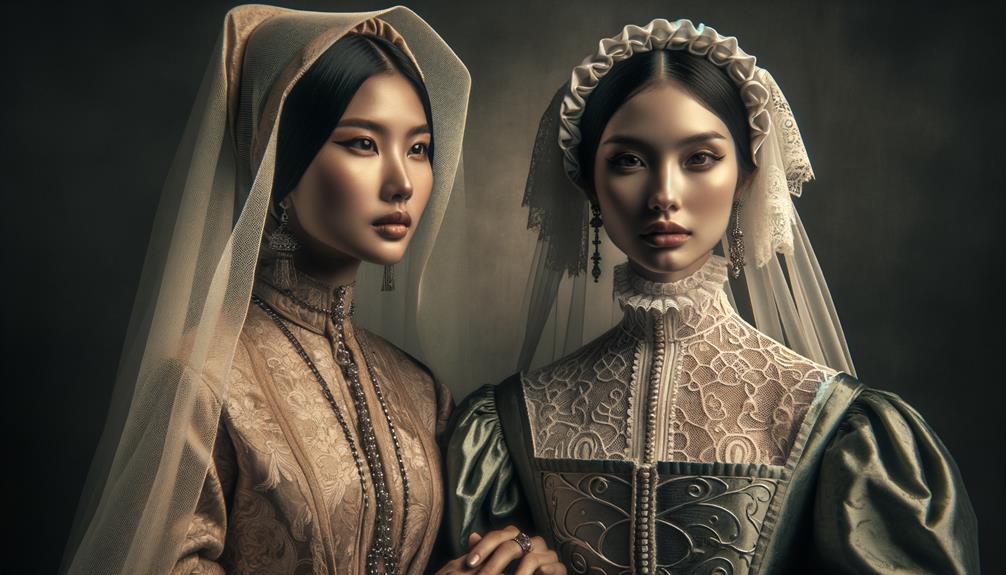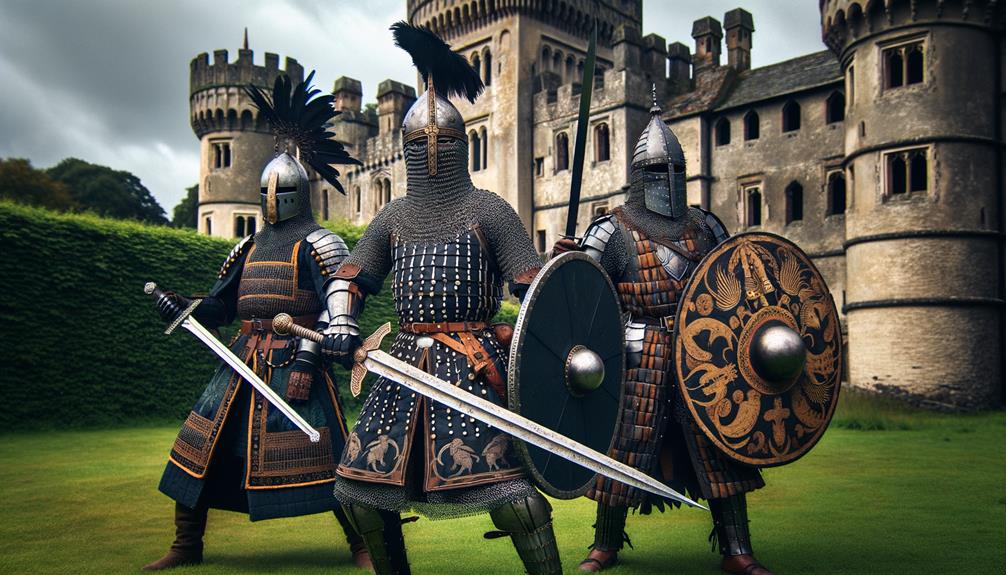I find it fascinating how medieval fashion wasn't just about aesthetics, but also served as a silent communicator of social status. The clothes people wore conveyed a wealth of information about their rank, beliefs, and values. Luxurious fabrics like silk and velvet were more than just comfortable; they signified wealth and power. Colors carried deep meanings – red for opulence, blue for nobility, and white for purity. Intricate embroidery and accessories weren't mere decorations but symbols of status. I often wonder how these subtle cues influenced daily interactions and perceptions back then. What can these choices tell us about the unspoken hierarchies and social norms of medieval life?
Social Hierarchy and Clothing
In medieval society, your clothing was a clear indicator of your social standing. What you wore wasn't just about covering your body; it was a visual representation of your status and wealth. The rich and powerful wore elaborate outfits in expensive hues like red, signifying their elite position. For example, scholars wore prestigious red robes, which reflected their high place in the social hierarchy and their access to costly materials.
In contrast, peasants wore simple, undyed wool garments that spoke to their lower standing. The lack of vibrant colors and fine fabrics in their clothing was a deliberate distinction, maintaining the structure of medieval society.
Different professions also had distinct styles. Monks, doctors, and knights each had unique attire, making it easy to recognize their roles and ranks. The fashion choices of courtiers, often impractical and extravagant, further highlighted their privileged status. Laws, such as the one in 1463, restricted revealing attire to the upper echelons, reinforcing the social hierarchy through clothing.
Manuscript illuminations of historical figures used these dressing conventions, ensuring everyone knew their place. In medieval society, clothing wasn't just about aesthetics; it was about defining one's identity and social position.
Fabrics and Materials
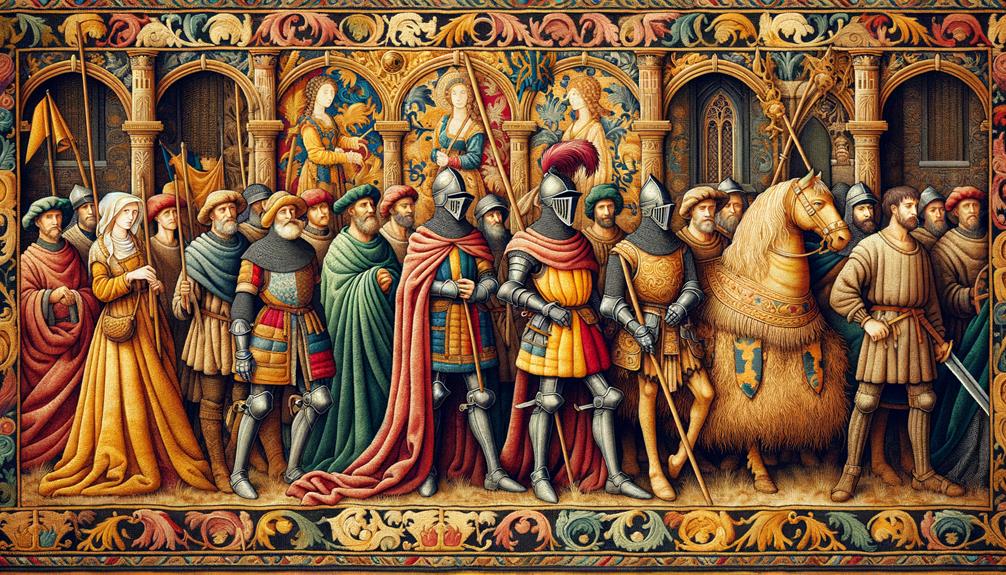
Medieval fashion's complexity was deeply rooted in the diverse fabrics and materials that defined each garment's purpose and prestige. Undyed wool, a humble yet essential material, provided warmth and practicality for the masses. Its unassuming nature reflected the everyday resilience of common folk.
Silk, on the other hand, exuded opulence. Imported and costly, it adorned the elite, its shimmering texture a silent testament to status. Rich dyes enhanced its allure, making it a coveted fabric in medieval courts. Fur played a dual role – providing functional warmth for some, while serving as an emblem of affluence for others. The nobility's garments were often lined or trimmed with luxurious furs, signifying their elevated position.
The dyeing techniques of the era were both an art form and a science. They transformed plain textiles into vibrant statements. However, the high cost of dyes made richly colored fabrics exclusive. As a result, pastel clothing emerged as a more accessible alternative. These softer hues, achieved with less expensive dyes, allowed broader social classes to partake in the fashion tapestry of the time.
Reflecting on these materials, it's clear that fabric choices mirrored not just practical needs but also social aspirations. It's a subtle dance between utility and symbolism, speaking volumes without explicit declaration.
Colors and Their Meanings

Colors in medieval fashion conveyed a silent language, where each hue carried its own significance and meaning. Red was synonymous with wealth and prestige, reserved for nobility and clergy due to the expensive dye. It symbolized status, making it more than just a color.
Blue embodied divine grace and nobility, often worn by royalty and rulers. The color conveyed a sense of elevated purpose and authority, making blue garments a demonstration of one's right to rule.
Green represented fertility, rebirth, and hope, frequently worn by knights and hunters. The color paid silent tribute to nature's cycles and the promise of new beginnings, making it more than just attire – a declaration of life and energy.
White epitomized purity, innocence, and light, often worn by brides, children, and the clergy. White garments symbolized unblemished virtue and spiritual clarity, making them more than simple clothing.
Black denoted power, formality, and mystery, favored by the wealthy, especially in mourning. Black was more than just a shade – it represented authority and the enigmatic nature of life and death.
Noble Attire
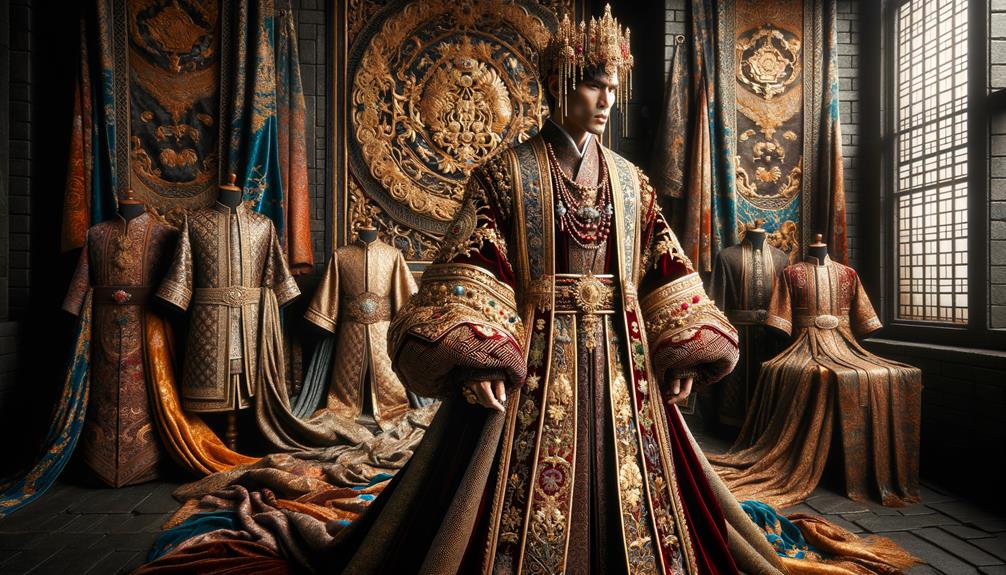
When I think about noble attire in the Middle Ages, I envision a striking display of power and social standing. Luxurious fabrics and rich colors weren't just for aesthetics; they were a status symbol, signaling wealth and social hierarchy. Elaborate jewelry and accessories further reinforced one's influence and position within society.
Colors and Their Meanings
In medieval Europe, fashion wasn't just about looking good – it was a complex language that conveyed social status and wealth. Each color had a unique meaning, silently communicating a person's position in society.
Gold and silver fabrics were reserved for the extremely wealthy, while purple, a rare and expensive dye, was often worn by royalty to symbolize power and luxury. Blue, on the other hand, signified piety and humility, commonly worn by devout nobles and clergy as a statement of their spiritual devotion. Green, representing nature and fertility, was worn by nobles to showcase their connection to the land and their prosperity.
| Color | Symbolism |
|---|---|
| Gold | Wealth, Prosperity |
| Purple | Power, Luxury |
| Blue | Piety, Humility |
| Green | Nature, Fertility |
| Silver | Wealth, Prestige |
It's clear that these colors were more than just a fashion choice – they were deliberate statements that conveyed a message without saying a word. The palette of noble attire was strategic and beautiful, conveying important information about the wearer's status and values.
Fabrics and Social Status
During the medieval period, the wealthy elite flaunted their status through luxurious fabrics that conveyed power and prestige. Silk, velvet, and fur were more than just materials – they were symbols of social standing. Wearing silk wasn't just about comfort; it was a bold declaration of affluence and exclusivity.
Velvet's unique texture whispered opulence, and its presence in clothing spoke volumes about one's place in the social hierarchy. The nobility's fondness for velvet attire was a clear indication of their elevated status. Velvet's tactile experience embodied the essence of luxury.
Fur, too, held a special place in the elite's wardrobe. More than just a means of warmth, fur signified prestige and wealth. The use of fur in cloaks and linings showcased the wearer's significant wealth and social standing, wrapping them in both physical and symbolic comfort.
In medieval society, the fabrics one wore conveyed more than just personal style; they were a statement of power and position. The deliberate choice of silk, velvet, and fur reflected and reinforced the social hierarchy of the time.
Accessories as Power Symbols
In medieval society, noble accessories like brooches and jeweled belts served as more than just adornments – they were clear indicators of wealth and influence. These items conveyed a person's standing in the social hierarchy, with precious stones and intricate craftsmanship signifying authority and commanding respect.
The materials used in these accessories, such as gold and silver, reflected the wearer's wealth and status. Noble attire was a visual representation of the hierarchical structure of medieval society, with each accessory reinforcing the wearer's position.
Rings and necklaces also played a significant role in displaying power and prestige. In a society where appearance mattered, these accessories were essential in conveying a noble's influence and authority. Every detail, from the type of metal to the arrangement of gems, was a deliberate statement of wealth and power.
In essence, noble accessories were declarations of dominance and prestige, showcasing the wearer's status and influence.
Commoners' Garb
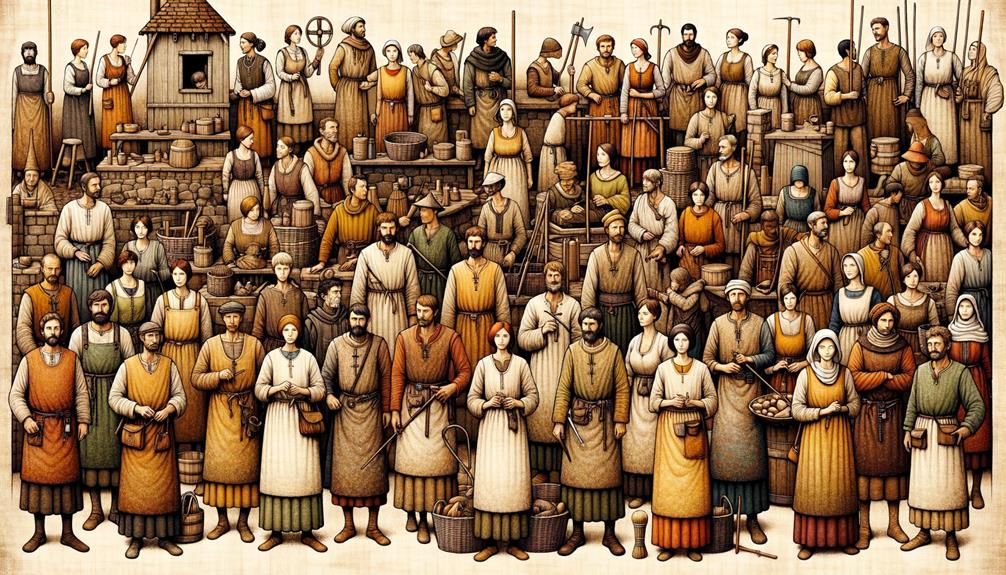
Commoners' Garb
In medieval times, everyday people wore simple, practical clothing that reflected their limited means and social status. They made do with affordable materials like undyed wool, a far cry from the luxurious fabrics and vibrant colors favored by the nobility. This choice of material wasn't just about saving pennies; it was also a clear indication of their lower social standing.
Common folk typically wore simple tunics, hose, and hoods. These garments prioritized function over fashion, providing ease of movement and durability needed for daily labor. The muted, earthy tones of their attire were a result of the limited availability and affordability of dyes. These colors weren't just a fashion statement; they were a reflection of the wearer's place in the social hierarchy.
Accessories were minimal for commoners. Any adornment they did wear served a practical purpose, such as belts to secure tools or simple pouches to carry essentials. There was little room for decorative elements in their daily lives. The simplicity of their garb silently echoed their laborious existence, a stark reminder of the divide between the classes.
Religious Vestments

When I gaze upon medieval religious vestments, I'm struck by the intricate tapestry of colors, patterns, and hierarchies. Each hue, from the regal purple to the radiant gold, holds profound spiritual significance. The meticulous embroidery and distinct attire of clergy members served as a testament to a sacred order, evoking reverence for the divine.
Ecclesiastical Color Significance
In medieval times, the colors of ecclesiastical vestments held profound symbolic meanings that enriched religious ceremonies. The medieval church used color symbolism to convey spiritual messages. Each hue in religious vestments had a specific purpose and message. White represented purity, an emblem of the divine and the holy. Red, symbolizing love and sacrifice, often adorned garments during significant feasts.
Green signified hope and growth, serving as a reminder of renewal and life's cycle. Blue represented heavenly grace and truth, lifting the spirit towards the divine. Purple, with its dual meanings of royalty and penitence, reflected both the majesty of God and the humility of human repentance.
Gold embroidery symbolized divine light and glory, a shimmering reminder of celestial splendor. Silver threads stood for purity and redemption, echoing the themes of spiritual cleansing. These ecclesiastical colors were chosen meticulously to align with the liturgical calendar. Each vestment added depth to the rituals, making ceremonies not just acts of faith but visually rich experiences.
The use of these symbolic colors turned every garment into a canvas of spiritual expression, deeply connecting the medieval church's followers to their faith.
Sacred Embroidery Patterns
Sacred embroidery on medieval religious vestments transformed plain fabric into a tapestry of faith and devotion. Each stitch, carefully placed, told a story of spiritual significance. The intricate designs weren't just embellishments; they were symbols of reverence and belief.
In the medieval period, embroidery on religious vestments held profound meanings:
- Symbols: Crosses, angels, and biblical scenes were common, each symbolizing different aspects of faith.
- Devotion: The meticulous nature of the work reflected the dedication of those who created and wore these garments.
- Worship: Embroidery was seen as an act of worship, each thread a prayer.
- Visual Representation: These patterns served as a visual manifestation of faith during religious ceremonies.
Observing these sacred patterns, one can't help but reflect on their purpose. They weren't just for decoration but were deeply entwined with the spiritual life of the time. The sacred embroidery on these vestments showcased the medieval church's commitment to honoring the divine. It's fascinating to think how each stitch carried not just thread, but the weight of devotion and faith, turning simple fabric into a sacred artifact.
Liturgical Garment Hierarchies
Liturgical garments in medieval times clearly reflected the ranks within the clergy, each piece a visual cue to their sacred roles and authority. The Pope's vestments, often adorned with gold and intricate embroidery, broadcasted his supreme authority in the church. This hierarchy wasn't just about appearances; it held deep symbolic meaning.
Bishops wore garments like the mitre, crozier, and pectoral cross, which reflected their elevated status and responsibilities within medieval Christianity. These items weren't mere accessories; they served as a constant reminder of the spiritual and administrative duties bestowed upon them.
Priests and deacons donned specific vestments such as the chasuble and stole, which indicated their roles during religious ceremonies, creating a visual distinction within the clergy. The chasuble's flowing fabric and the stole's linear design both held theological significance, portraying the wearer's connection to divine service and spiritual leadership.
The symbolism embedded in these liturgical garments extended beyond their hierarchy. They represented broader spiritual concepts and theological beliefs, weaving the clergy's roles into the very fabric of medieval society. These garments were a reflection of the intricate interplay of faith, authority, and tradition in medieval Christianity.
Frequently Asked Questions
What Were the Characteristics of Medieval Fashion?
Medieval fashion was a rich tapestry of social hierarchy. Luxurious fabrics like silk and velvet were reserved for royalty, while nobles flaunted their wealth with jewels and furs. In contrast, peasants made do with humble materials like wool and linen. Intricate accessories told stories of status and belief, blending function with symbolism.
What Is the Symbolism of Fashion?
Fashion's symbolism reflects our identity, status, and beliefs, making it a powerful tool for non-verbal communication. When I get dressed, I'm not just picking out clothes – I'm expressing myself, telling my story, and connecting with others on a deeper level.
Why Was Fashion Important in the Medieval Times?
When I put on a silk robe, everyone knew I was a noble. In medieval times, fashion was a status symbol, clearly indicating social ranks and professions through specific fabrics and styles.
What Is the Symbolic Meaning of Clothes?
Clothes reflect our identity, social status, and personal values. Every stitch, every embellishment, tells a story about who we are and what we believe in.



